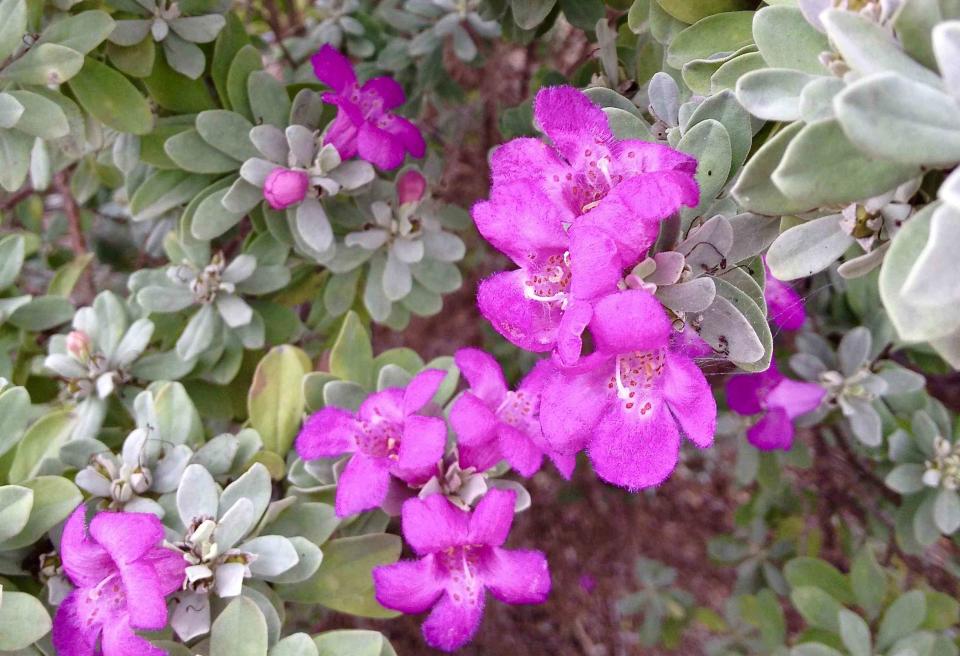How To Grow And Care For Texas Sage
No plant takes the heat better than this beautiful blooming bush.

Diana C. Kirby
Fact checked by Khara Scheppmann
Often referred to as barometer bush, Texas sage (Leucophyllum frutescens) dazzles with bright pink to lavender or white blooms after rainfalls from summer through fall. The silvery leaves of Texas sage offer a visual respite in the height of summer heat. Its gray, green, or silver one-inch leaves are fuzzy, and provide a delicate backdrop for the vibrant flowers.
Once established, Texas sage thrives in rocky soil and rough conditions. Drought- and heat-tolerant, this woody, upright shrub typically grows five to eight ft. tall, and four to six ft. wide. Here's everything you need to know to grow and care for Texas sage.
Plant Attributes
Common Name | Texas Sage, Barometer Bush, Purple Sage, Cenizo |
Botanical Name | Leucophyllum frutescens |
Family | Scrophulariaceae (Figwort Family) |
Plant Type | Shrub |
Mature Size | 5-5 ft. tall, 4-6 ft. wide |
Sun Exposure | Full Sun, Partial Shade |
Soil Type | Rocky, well-drained soil, caliche |
Soil pH | Slightly acidic to moderately alkaline |
Bloom Time | Summer into fall |
Flower Color | Pink, Purple, Lavender, White |
Hardiness Zones | 8-10 (USDA) |
Native Area | North America |
Texas Sage Care
Texas sage is a woody evergreen shrub. It thrives in full sun and will tolerate partial shade. Low maintenance, Texas sage doesn’t mind rocky soil and doesn’t require fertilizing.
Light
Full sun to partial shade will yield the most blooms.
Soil
Texas sage needs good drainage. It will grow in a variety of rocky soils but doesn’t like wet feet.
Water
Once established, it doesn’t need regular watering.
Temperature and Humidity
Texas sage is both heat and cold-tolerant to 12ºF, It blooms with the onset of rain, increased humidity, and changes in barometric pressure.
Fertilize
No need to fertilize.
Types of Texas Sage
'Green Cloud' has light green foliage with dark pink to magenta blooms and is a more prolific bloomer than other varieties.
'Silverado' has fuchsia blooms on silver foliage and is a slightly denser variety.
'Compact' has showy hot pink blooms with silvery leaves and grows only three ft. tall and three ft. wide, providing more planting placement options in the landscape.
'Desperado' is five ft. tall and five ft. wide with silvery-green foliage and lavender-pink blooms.
'Lynn’s Legacy' has dense green foliage with prolific blooms, typically growing to five ft. tall, and five ft. wide.
Pruning
When not in full sun, Texas sage can get leggy. Prune in late winter to shape and encourage bushier growth.
Propagating
Texas sage can be propagated from semi-hardwood cuttings or softwood cuttings.
How to Grow from Seed
Seeds should be collected before the pod dries and splits open. Plant in spring after last frost.
Overwintering
Texas sage is evergreen and does not need overwintering care.
Common Pests and Diseases
Texas sage can suffer from cotton root rot if planted without sufficient drainage or if overwatered. Planting in a sunny location with well-drained soil will prevent this.
Common Problems
Planting in too much shade may lead to leggy plants. Regular pruning will keep Texas sage bushy and full.
For more Southern Living news, make sure to sign up for our newsletter!
Read the original article on Southern Living.

